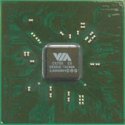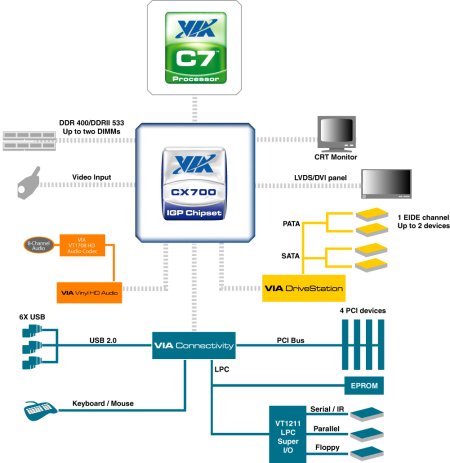Via embedded chipset merges north-, south-bridges, runs Linux
Apr 4, 2006 — by LinuxDevices Staff — from the LinuxDevices Archive — 25 views Via is sampling a “single-chip chipset” that supports Linux, and targets PC/104 and mini-ITX boards, POS (point-of-sales/service) devices, industrial PCs, and thin clients. The CX700 chipset measures 37.5mm square, and provides north- and south-bridge functionality, with integrated graphics. It supports Via's C7 and Eden x86-compatible processors.
Via is sampling a “single-chip chipset” that supports Linux, and targets PC/104 and mini-ITX boards, POS (point-of-sales/service) devices, industrial PCs, and thin clients. The CX700 chipset measures 37.5mm square, and provides north- and south-bridge functionality, with integrated graphics. It supports Via's C7 and Eden x86-compatible processors.
The CX700 chipset supports Via's C7 “desktop” CPUs, C7-M mobile CPUs, and C7-M ULV (ultra-low voltage) CPUs for extremely power-sensitive mobile applications. It also supports Via's Eden and Eden ULV CPUs, which currently support passive cooling at clockspeeds up to 1.5GHz. Eden CPUs use the same die as Via's C-series CPUs, but with smaller packaging, and extra processing and testing for higher heat tolerances.
CX700 features and specs
Via says its CX700 requires 34 percent less board surface area than x86-compatible chipsets based on separate north- and south-bridges. It plans to use the chipset in its popular “Epia” line of mini-ITX boards, it says, and it hopes the chipset's small size, low power, and high performance will appeal to PC/104 board integrators. Early CX700 customers include board vendors Advantech, Diamond Systems, Freetech Flexus Computer Technology, and WinSystems, it says, several of which are reportedly demonstrating CX700-based boards at the Embedded Systems Conference (ESC) this week.
Via says that compared to other ultra-compact x86-compatible chipsets, the CX700 offers unprecedented performance, along with low power requirements that complement the efficiency of its C7 and Eden processors, claimed to offer the highest performance-per-Watt ratio in the x86-compatible chip market. The CX700 has a maximum power envelope of 3.5 Watts, Via claims.

CX700 block diagram
(Click to enlarge)
The CX700's built-in graphics are based on Via's mature 128-bit UniChrome Pro IGP core, which offers stable 2D performance under Linux using open source drivers. The UniChrome core also provides 3D and MPEG-2 acceleration, when driven by binaries released by Via for the kernels included in major desktop distributions.
Graphics features aimed at embedded developers include TV-out, and a multi-configuration LVDS transmitter, which can be used along with inverter circuitry to attach LCD display modules or DVI interfaces. Dual-screen display is said to be possible, using Via's “DuoView” technology.
The CX700 also integrates a Vinyl HD audio controller, said to support up to eight “high-definition” channels.
The CX700 includes a modern memory controller that supports DDR2 533 or DDR 400 RAM. Both 32- and 64-bit memory chips are supported, in capacities up to 4GB, with ECC (error correction codes).
Additional on-chip peripheral interfaces include:
- Hard drives
- Serial ATA (S-ATA)
- SATA II
- Traditional parallel ATA (P-ATA)
- 2x COM
- 6 x USB 2.0
- 4 x PCI slots
Additionally, ISA bus support can be added through an available Via “ITE PCI” bridge chip. The company notes that legacy systems that use ISA peripherals can have their lifespan extended significantly through an upgrade to DDR2 memory.
Via's increased focus on embedded
Via appears to be taking increasing notice of the embedded market. The company launched a “CoreFusion” line of chipsets about a year ago that wed its Eden embedded processors with several northbridge designs. A low-end “Mark” model integrates a northbridge featuring a legacy ISA (PC) bus — quite a rarity these days — while a higher-end “Luke” chip integrates a northbridge that supports DDR RAM and other modern innovations. A planned “John” CoreFusion chip will integrate CPU, northbridge, and southbridge into a single x86-compatible SoC (system-on-chip).
The new CX700 chipset is the second Via chipset to support its relatively new C7 processors. The first, the VN800, also supports Intel Pentium M processors, to give laptop makers “maximum flexibility,” the company said last fall when it introduced the VN800.
The as-yet-unannounced VX700, quietly demonstrated last month at CeBIT in connection with the launch of Ultra Mobile PCs (UMPCs, aka “Origami” devices), does for Via's mobile CPUs and chipsets what the CX700 does for its embedded chips. Specifically, it combines the VN800 northbridge and VT8237 southbridge chip features, along with a number of other mobile-oriented functions, according to Via.
Chinhwaun Wu, special assistant to Via's president, stated, “The CX700 looks set to drive x86 further into the embedded space.”
Jeff Chen, CTO of board vendor Advantech, stated, “With the VIA CX700, Advantech's SOM-ETX can [support] dual screens, CRT/TV, and direct LVDS connection.”
Bob Burckle, VP of WinSystems, stated, “Highly integrated, very low-power products like the CX700 are key to small, high-performance single board computer designs.”
Matt Schiltz, CEO of General Software, stated, “Via's embedded chipset family is setting new standards for low power dissipation at a high performance level. We are pleased to offer Embedded BIOS 2000 support for the CX700.”
Availability
The CX700 is sampling now, with volume availability expected this quarter. Pricing was not disclosed.
This article was originally published on LinuxDevices.com and has been donated to the open source community by QuinStreet Inc. Please visit LinuxToday.com for up-to-date news and articles about Linux and open source.